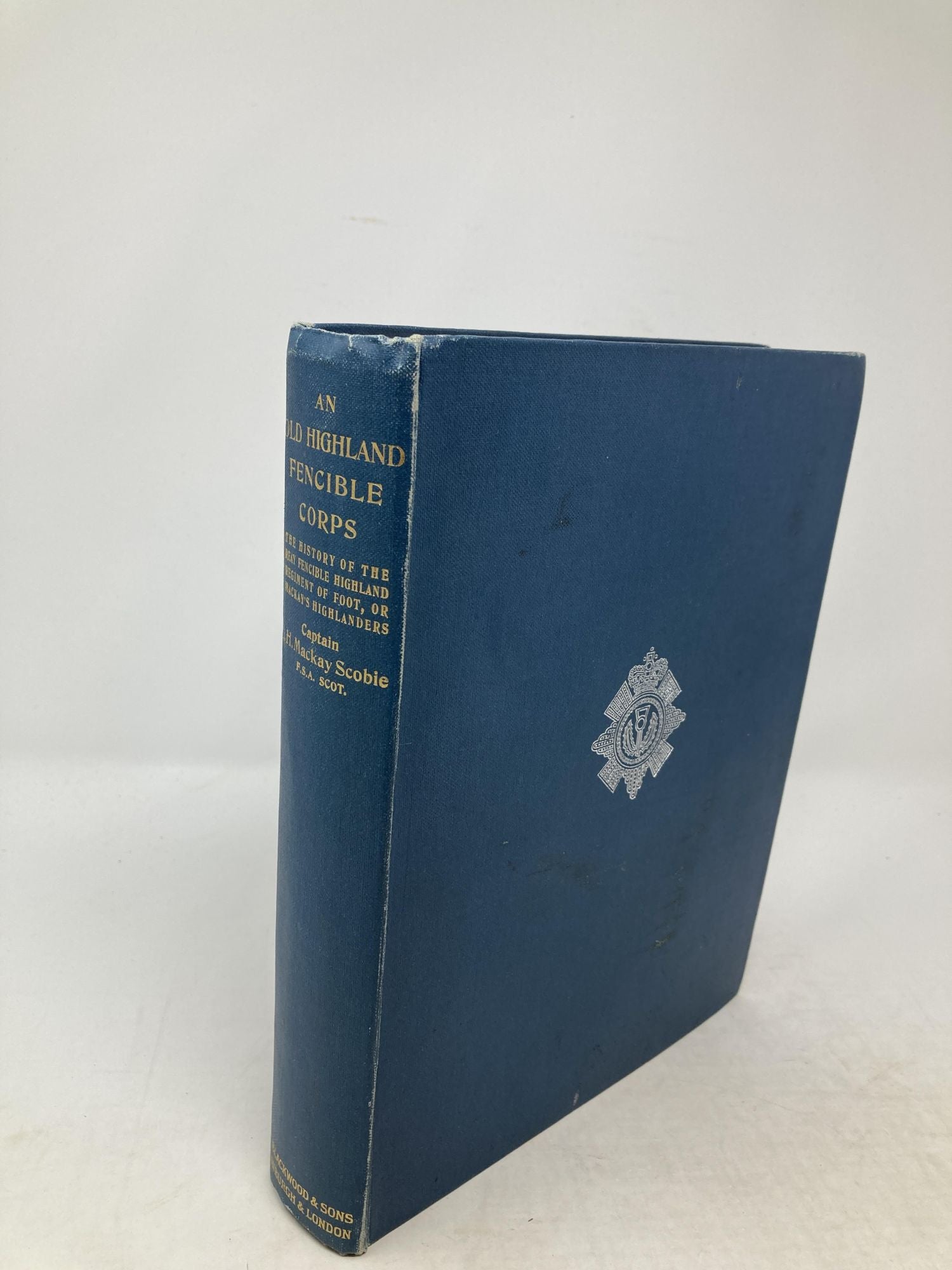
Author: Scobie, I.H. Mackay
Title: An Old Highland Fencible Corps : The History of the Reay Fencible Highland Regiment of Foot, or Mackay's Highlanders 1794-1802 : With an Account of Its Services in Ireland During the Rebellion of 1798; (with Illustrations and Maps)
Description: Edinburgh, Scotland, William Blackwood and Sons, 1914. Hardcover. Quarto, 10.4 in. x 8 in. pp. xlii, 413. Illustrated with color tissue-guarded frontispiece, thirty-nine color and black and white plates, and two maps bound at rear endpapers: a color "Map of Sutherland and Caithness" and a fold-out map (14.75 in. x 11.5 in) "To Illustrate the Movements of the Reay in Ireland." Dark teal cloth-covered boards with silver emblem to front and gilt title to spine. Top edge gilt. Untrimmed fore- and bottom-edges. Occasional light foxing throughout. Spine and hinges tight. The plan of raising a fencible corps in the Highlands was first proposed and carried into effect by William Pitt the Elder in 1759. During the three preceding years both the fleets and armies of Great Britain had suffered reverses, and it was thought that a "home guard" was necessary as a bulwark against invasion. In England county militia regiments were raised for internal defence in the absence of the regular army; but it was not deemed prudent to extend the system to Scotland, the inhabitants of which, it was supposed, could not yet be safely entrusted with arms because of The 'Fifteen' and The 'Forty-Five' rebellions. Groundless as the reasons for this caution undoubtedly were in regard to the Lowlands, it would certainly have been hazardous at a time when the Stuarts and their adherents were still plotting a restoration to have armed the clans. An exception, however, was made in favour of the people of Argyle and Sutherland, and accordingly letters of service were issued to John Campbell, 5th Duke of Argyll, then the most influential and powerful nobleman in Scotland, and William Sutherland, 18th Earl of Sutherland to raise, each of them, a fencible regiment within their districts. Unlike the militia regiments which were raised by ballot, the fencibles were to be raised by the ordinary mode of recruiting, and like the regiments of the line, the officers were to be appointed, and their commissions signed by the king. The same system was followed at different periods down to the year 1799, the last of the fencible regiments having been raised in that year. (from Wikipedia). Very Good .
Keywords: Irish Military, History of Ireland
See more books from our catalog: Irish & Ireland
Title: An Old Highland Fencible Corps : The History of the Reay Fencible Highland Regiment of Foot, or Mackay's Highlanders 1794-1802 : With an Account of Its Services in Ireland During the Rebellion of 1798; (with Illustrations and Maps)
Description: Edinburgh, Scotland, William Blackwood and Sons, 1914. Hardcover. Quarto, 10.4 in. x 8 in. pp. xlii, 413. Illustrated with color tissue-guarded frontispiece, thirty-nine color and black and white plates, and two maps bound at rear endpapers: a color "Map of Sutherland and Caithness" and a fold-out map (14.75 in. x 11.5 in) "To Illustrate the Movements of the Reay in Ireland." Dark teal cloth-covered boards with silver emblem to front and gilt title to spine. Top edge gilt. Untrimmed fore- and bottom-edges. Occasional light foxing throughout. Spine and hinges tight. The plan of raising a fencible corps in the Highlands was first proposed and carried into effect by William Pitt the Elder in 1759. During the three preceding years both the fleets and armies of Great Britain had suffered reverses, and it was thought that a "home guard" was necessary as a bulwark against invasion. In England county militia regiments were raised for internal defence in the absence of the regular army; but it was not deemed prudent to extend the system to Scotland, the inhabitants of which, it was supposed, could not yet be safely entrusted with arms because of The 'Fifteen' and The 'Forty-Five' rebellions. Groundless as the reasons for this caution undoubtedly were in regard to the Lowlands, it would certainly have been hazardous at a time when the Stuarts and their adherents were still plotting a restoration to have armed the clans. An exception, however, was made in favour of the people of Argyle and Sutherland, and accordingly letters of service were issued to John Campbell, 5th Duke of Argyll, then the most influential and powerful nobleman in Scotland, and William Sutherland, 18th Earl of Sutherland to raise, each of them, a fencible regiment within their districts. Unlike the militia regiments which were raised by ballot, the fencibles were to be raised by the ordinary mode of recruiting, and like the regiments of the line, the officers were to be appointed, and their commissions signed by the king. The same system was followed at different periods down to the year 1799, the last of the fencible regiments having been raised in that year. (from Wikipedia). Very Good .
Keywords: Irish Military, History of Ireland
Price: US$ 160.00 Seller: Aardvark Books
- Book number: 86359
- Book number: 86359
See more books from our catalog: Irish & Ireland